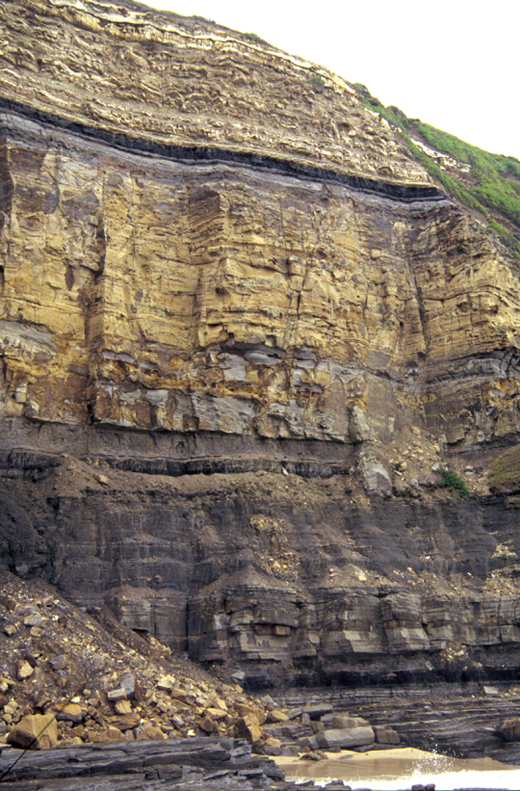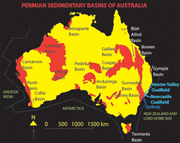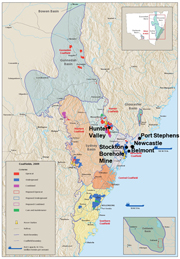Newcastle Coal Measures
Newcastle — Hunter Valley Coalfield floras
The Newcastle and Hunter Valley coalfields, located in the northern Sydney Basin, NSW (Figs 1, 2), contain very large reserves of bituminous coal suitable for thermal (energy production) and coking (metallurgical) purposes. Coal was recognized in these areas by early European explorers and the first shaft was sunk near the Hawkesbury River in 1799 (with drilling equipment sent by Joseph Banks). In the 2008-09 financial year 135.9 Million tonnes of saleable bituminous coal were produced from NSW, a large proportion coming from the Newcastle-Hunter district (Australian Coal Association statistics). The coal is mined by both underground and open cut methods. The coals mined in these areas are of Middle to Late Permian age (from the Tomago and Newcastle coal measures). Geological summaries of the coalfields were published by Diessel (1980), Agnew et al. (1995) and Sniffin & Beckett (1995).
Plant fossils are abundantly preserved in shales associated with the coals and the floras are invariably dominated by glossopterid gymnosperms. Equisetaleans, ferns, cordaitaleans and conifers constitute lesser components of the floras. Fossil plants from this region have been studied episodically over the past century, but no comprehensive survey of the fossil assemblages has been undertaken. Some key studies include those of Etheridge (1903), Saksena (1952), Townrow (1955), Rigby (1966, 1972), Rigby et al. (1980), White (1978, 1986) and McLoughlin (1990).
NRM has very small plant fossil collections from several sites in this region as outlined below.
Stockton Borehole Colliery - Flora of the Tighes Hill Formation
The Stockton Borehole Colliery is located near Teralba at the northern end of Lake Macquarie, about 20 km southwest of Newcastle (Fig. 2). Coalmines have operated in this area since the 1800s, exploiting various seams of Middle to Late Permian age from the Tomago and Newcastle Coal Measures. The Stockton Borehole Colliery was operationally merged with its neighbour Macquarie Colliery in 1988. Operations in the Stockton Borehole underground mine extracted coal from the Borehole Seam, which is located near the base of the Lambton Subgroup, the basal unit of the Newcastle Coal Measures (Upper Permian). The NRM collections hold a single rock slab bearing many Glossopteris leaves from a bed immediately overlying the Borehole Seam, presumably from the Tighes Hill Formation, which is dominated by fine-grained sedimentary rocks that accumulated in lacustrine deltas (Agnew et al. 1995).
Port Stephens
Port Stephens is located about 50 km northeast of Newcastle on the northeastern limit of the Sydney Basin (Fig. 2). No precise locality or stratigraphic data is available for the single specimen (bearing Glossopteris browniana leaves) from this site.
Belmont
Belmont is located about 10 km south of Newcastle and just east of Lake Macquarie (Fig. 2). This area is famous for several sites that contain rich Permian insect faunas (see Beattie 2007 for a recent study). The single NRM specimen available from Belmont bears a Glossopteris leaf. The likely source of this fossil is the Upper Permian Newcastle Coal Measures.
Newcastle
Several fossiliferous sites are known around Newcastle city. Some of the best known are in coastal cliff exposures (Fig. 3) and it is possible that the 10 specimens held in the NRM collections derive from these outcrops. The likely source of these fossils is the Upper Permian Newcastle Coal Measures.
Hunter River
Five specimens in the NRM collections are labelled as “Hunter Valley" or “near the source of the Hunter River". Several major coal mines and many fossiliferous outcrops are known from this region. No precise locality or stratigraphic position can be given for these samples, although they likely derive from either the Tomago or Newcastle coal measures (Middle to Late Permian).
References
Beattie, R., 2007. The geological setting and palaeoenvironmental and palaeoecological reconstructions of the Upper Permian insect beds at Belmont, New South Wales, Australia. African Invertebrates 48, 41-57.
Etheridge, R., 1903. Further observations on the caudex of Glossopteris. Records of the Australian Museum 5, 46-49.
Diessel, C.F.K., 1980. Newcastle and Tomago Coal Measures. In Herbert, C. & Helby, R. (editors). A guide to the Sydney Basin. Geological Survey of N.S.W. Bulletin 26, 100-114.
McLoughlin, S., 1990. Late Permian glossopterid fructifications from the Bowen and Sydney Basins, eastern Australia. Geobios 23, 283-297.
Rigby, J.F., 1966b. Some Lower Gondwana articulates from New South Wales. Symposium on floristics and stratigraphy of Gondwanaland. Birbal Sahni Institute of Palaeobotany, Lucknow, 48-54.
Rigby, J.F., 1972. On Arberia White, and some related Lower Gondwana female fructifications. Palaeontology 15, 108-120.
Rigby, J.F., Maheshwari, H.K. & Schopf, J.M., 1980. Revision of the plants collected by J.D. Dana during 1839-1840 in Australia. Geological Survey of Queensland Publication 376, Palaeontological Paper 47, 1-25.
Saksena, S., 1952. On a new species of Phyllotheca (P. sahnii) from the South Rewah Gondwana Basin, Central India, and its comparison with P. etheridgei from the Newcastle Series, New South Wales, Australia. Palaeobotanist 1, 409-416.
Sniffin, M.J. & Beckett, J., 1995. Sydney Basin — Hunter Coalfield. In Geology of Australian Coal Basins. C.R. Ward, H.J. Harrington, C.W. Mallett & J.W. Beeston, eds, Geological Society of Australia Inc. Coal Geology Group, Special Publication No. 1, 177-195.
Townrow, J.A., 1955. On some species of Phyllotheca. Journal and Proceedings of the Royal Society of N.S.W. 83, 39-63.
White, M.E., 1978. Reproductive structures of the Glossopteridales in the Australian Museum. Records of the Australian Museum 31, 473-504.
White, M.E., 1986. The Greening of Gondwana. The 400 Million Year Story of Australia´s plants. Reed, Frenchs Forest, NSW, 256 pp.

Fig. 3. Coal seams of the Upper Permian Newcastle Coal Measures exposed in coastal cliffs at Newcastle, NSW. Photo: S. McLoughlin 1994.




